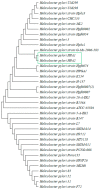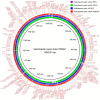Identification, Genome Sequencing, and Characterizations of Helicobacter pylori Sourced from Pakistan
- PMID: 38004670
- PMCID: PMC10673187
- DOI: 10.3390/microorganisms11112658
Identification, Genome Sequencing, and Characterizations of Helicobacter pylori Sourced from Pakistan
Abstract
The stomach's colonization by Helicobacter pylori (H. pylori) results in gastritis, ulcers, and stomach cancer. Frequently, pain is treated with medication, but resistant H. pylori infections are not. Therefore, it is important to find pharmacological targets and improved treatments for resistant H. pylori strains. The aim of the current study was sampling, identification, drug susceptibility testing following genome sequencing and comparative genome-wide analysis of selected H. pylori strains from Pakistan with three representative strains for virulence and drug-resistant characteristics. Based on culture, biochemistry, and molecular biology, 84 strains of H. pylori were identified, which made up 47% of the enrolled cases. Among all H. pylori strains, the highest resistance was reported for metronidazole with 82 H. pylori strains (98%), followed by clarithromycin with 62 resistant strains (74%). Among metronidazole-resistant strains, 38 strains (46%) were also resistant to clarithromycin, contributing 61% of clarithromycin resistant cases. Two strains, HPA1 and HPA2, isolated from 'gastritis' and 'gastric ulcer' patients, respectively, were further processed for WGS. The draft genome sequences of H. pylori strains HPA1 and HPA2 encode 1.66 Mbp and 1.67 Mbp genome size, 24 and 4 contiguous DNA sequences, and 1650 and 1625 coding sequences, respectively. Both the genomes showed greater than 90% similarity with the reference strain H. pylori ATCC 43504/PMSS1. The antibiotic-resistant genes were identified among all the strains with overall similarity above 95%, with minor differences in the sequence similarity. Using the virulent gene data obtained from the Virulence Factor Database, 75 to 85 virulent genes were identified in the five genome assemblies with various key genes such as cytolethal distending toxin (cdt), type IV secretion system, cag PAI, plasticity region, cell-motility- and flagellar-associated genes, neutrophil-activating protein (HP-NAP), T4SS effector cytotoxin-associated gene A (cagA), and urease-associated genes ureA and ureB, etc. Sequence similarity between the virulence factors found in this study and reference genes was at least 90%. In summary, the results of our study showed the relationship between clinical results and specific H. pylori strains' (HPA1 and HPA2) genetics such as antibiotic resistance and specific virulence factors. These findings provide valued understanding of the epidemiology of H. pylori-associated diseases. Moreover, identification and genomics analysis have provided insights into the epidemiology, genetic diversity, pathogenicity, and potential drug resistance genes of H. pylori strains, offering a foundation for developing more targeted and effective medical interventions, including anti-virulent medications.
Keywords: H. pylori; comparative analysis; drug resistance; epidemiology; genome; virulence.
Conflict of interest statement
The authors declare no conflict of interest.
Figures






References
LinkOut - more resources
Full Text Sources
Research Materials
Miscellaneous

